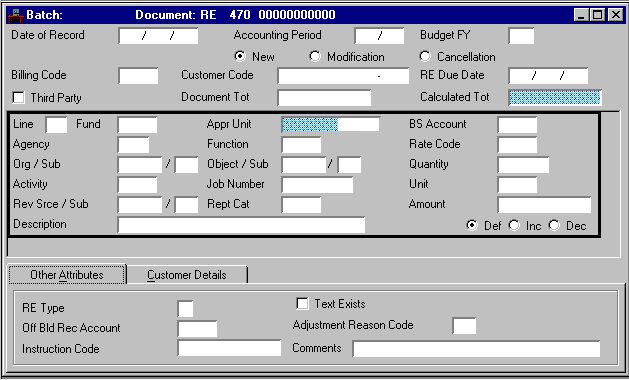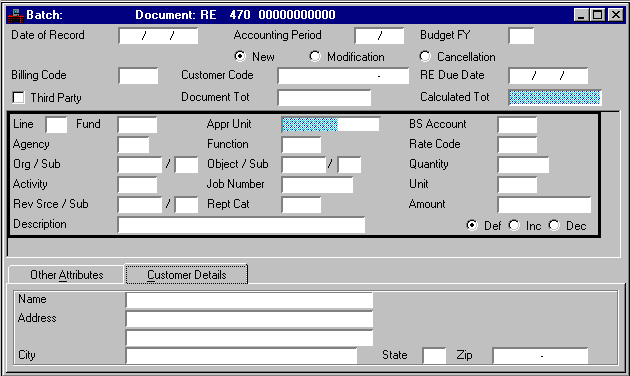|
|
|
|
Date of Record
|
Defaults to the current date. Enter the date (
mm dd yy
) of the receivable event.
|
|
Accounting Period
|
Default is inferred based on
Date of Record
. If entered, ensure that it is open. You cannot enter a future period.
|
|
Budget FY
|
Default is current fiscal year. If entered, ensure that it is open. You cannot enter a future fiscal year.
|
|
New/Modification/Cancellation [Action]
|
Blank defaults to
New [E]
for new entry. Select
Modification [M]
to indicate modification of a previously entered document. This allows the addition of new lines, increases/ decreases to existing line amounts or canceling of a line. (You must use a Receivable Credit Memo (RM) document to decrease the document total). Select
Cancellation [X] to cancel an existing document.
If you want to cancel an existing document, the document cannot have been referenced in any way. For example, you cannot cancel a receivable that is referenced by a Vendor Invoice (VI) document.
|
|
Billing Code
|
Defaults from Customer Information (CUS2) if a billing code is entered there. Required if no billing code is entered on Customer Information (CUS2). Enter the code that identifies the billing profile for invoice or statement generation. See Billing Profile (BPRO) for valid values.
|
|
Customer Code
|
Required. Enter the customer who is billed. See Customer Information (CUS2) for valid values.
|
|
RE Due Date
|
Optional. Date on which payment for the receivable is due. Enter this field (
mm dd yy
) only if
Billing Code
specifies invoice processing. If blank and the billing code specifies invoices, it defaults to:
Receivable Date +
Receivable Due Date Lag
(from Billing Profile (BPRO) or Revenue Options (ROPT))
If blank and
Billing Code
specifies statements or both invoices and statements, it defaults to:
Next statement date (based on the statement day) +
Receivable Due Date Lag
(from Billing Profile (BPRO) or Revenue Options (ROPT))
|
|
Third Party
|
Default is cleared [
N
]. If selected [
Y
], the invoice generated is sent to the third party specified on Customer Information (CUS2) for the entered customer. The name and address are inferred from Third Party Billing (TPAR) rather than Customer Information (CUS2).
|
|
Document Tot
|
Required. Enter the unsigned net amount of all lines entered on the document. To compute this amount for modification documents:
1. Add together the increase amounts.
2. Add together the decrease amounts.
3. Subtract the lesser of these from the greater and enter this amount.
|
|
Calculated Tot
|
The net total of the line amounts is computed by the system and displayed.
|
|
Line
|
Required. Enter a unique, two-digit number for each document line.
|
|
Fund
|
Required. Default is inferred from Organization (ORG2) based on the agency and organization entered on this document. See Fund Index (FUND) for valid values.
|
|
Agency
|
Required. Enter the agency for which the revenue was earned. See Agency Index (AGCY) and Fund Agency Index (FAGY) for valid values.
|
|
Org/Sub
|
Conditional. Required on revenue lines if
Revenue Budget Organization Option
on Fund Agency Index (FAGY) is
Y
(required on budget and accounting) or
A
(required on accounting). Required on expense lines if the
Expense Budget Activity Option
on Fund Agency Index (FAGY) is
Y
(required on budget and accounting) or
A
(required on accounting). Otherwise, the organization is used for reporting purposes only. See Organization Index (ORGN) for valid values.
Sub-Organization
is required on revenue transactions if
Sub-Organization Required on Revenue
is
Required [Y]
for a new document
on Organization (ORG2); or on expenditure transactions if
Sub-Organization Required on Spending
is:
Required [Y]
, or
Required on Expenditure Transactions [3]
. See Sub-Organization (SORG) for valid values.
|
|
Activity
|
Conditional. Required on revenue lines if
Revenue Budget Activity Option
on Fund Agency Index (FAGY) is
Y
(required on budget and accounting) or
A
(required on accounting).
Required on expense lines if the
Expense Budget Activity Option
on Fund Agency Index (FAGY) is
Y
required on budget and accounting) or
A
(required on accounting). Otherwise it is used for reporting purposes only. See Activity Index (ACTV) for valid values.
|
|
Rev Srce/Sub
|
Conditional. Required on all revenue transactions. Enter the revenue source that defines the type of revenue recorded on this line. See Revenue Source Index (RSRC) for valid values.
Sub-Revenue
is required if
Sub-Revenue Source Required
on Revenue Source (RSR2) is
Yes [Y]
. See Sub-Revenue Source (SREV) for valid values.
|
|
Description
|
Optional. Enter any additional information about a line here.
|
|
Appr Unit
|
Required. Enter the Program Budget Unit element for the items listed on this document. See Program Reference Table (PRFT) for valid values. The Appropriation Program element and Allotment Program element will be inferred from PRFT based on Program Budget Unit.
|
|
Function
|
Conditional. Required if
Expense Budget Function Option
on Fund Agency Index (FAGY) is
Y
(required on budget and accounting) or
A
(required on accounting) and if the receivable is referencing and expense budget line.
|
|
Object/Sub
|
Conditional. Required on reimbursement transactions only. Leave blank otherwise. See Object Index (OBJT) for valid values.
Sub-Object
is required on reimbursement transactions only if
Sub-Object Required
is selected [
Y
] on Expense Budget Inquiry (Extended) (EEX2). Leave blank if
Object
is not entered. See Sub-Object (SOBJ) for valid values.
|
|
Job Number
|
Conditional. Required on revenue transactions if
Job Number Required on Revenue
is
Required [Y]
; or
Required if Job Number Revenue is Required on Activity [A]
on Organization (ORG2). Required on expenditure transactions if
Job Number Required on Spending
on Organization (ORG2) is
Required on Expenditure Transactions [3]
or
Required if Job Number Spending is Required on Activity [A]
. See Job Index (JOBT) for valid values.
|
|
Rept Cat
|
Conditional. Required on revenue transactions if
Reporting Category Required on Revenue Transaction
is
Yes [Y]
on Agency (AGC2). Required on expenditure transactions if
Reporting Category
on Agency (AGC2) is:
Required on Pre-encumbrance Transactions [1],
Required on Encumbrance Transactions [2], or
Required on Expenditure Transactions [3].
See Reporting Category (RPTG) for valid values.
|
|
BS Account
|
Conditional. Required on balance sheet transactions; leave blank on revenue transactions. See Balance Sheet Account Index (BACC) for valid values.
|
|
Rate Code
|
Conditional. Required if
Amount
is blank. Enter the code used to define the billing rate per unit of measure. See Billing Rate (BRTE) for valid values.
|
|
Quantity
|
Conditional. Required if
Rate Code
is entered. Enter the number of units consumed by the customer.
|
|
Unit
|
Conditional. Required if
Rate Code
is entered. Enter the unit of measure of the goods consumed by the customer. If
Rate Code
is entered, this field is inferred from Billing Rate (BRTE).
|
|
Amount
|
Conditional. Required if either
Rate Code
or
Number of Units
is not entered. This is the dollar amount of the items described on the line. You can enter this manually, or let the system compute it as:
Billing rate (based on
Rate Code
) *
Number of Units
.
If this is a modification of a previous line, enter the amount of the increase or decrease here. The decimal point is optional, but you must enter two decimal places for cents.
Default/Increase/Decrease
indicates whether this field is added or subtracted from the original amount.
|
|
Def/Inc/Dec
|
Defaults to
Default [blank]
. Valid values on a modification transaction are
Increase [I]
or
Decrease [D]
. Valid values on a new transaction are
Default [blank]
or
Increase [I]
. Selecting Decrease [D] on a new transaction indicates that the receivable is establishing a credit balance.
|
|
|
|
|
RE Type
|
Optional. Enter the type of receivable document.
S
The receivable is a summary receivable and not for billing to customers.
I
Receivable contains only interest lines. All lines must contain the interest revenue source from Revenue Options (ROPT). (Modifying receivables only.)
L
Receivable contains only late fee lines. All lines must contain the late fee revenue source from Revenue Options (ROPT). (Modifying receivables only.)
|
|
Text Exists
|
Select the Text Exists flag to access Receivable Text (RETX) through the Additional Description tab in order to enter text. If selected [Y], the text flag on Open Receivable Header Inquiry (OREH) will be checked when the RE is processed.
|
|
Off Bld Rec Account
|
Default is inferred from Revenue Source Index (RSRC) or System Special Accounts (SPEC). Enter the balance sheet account used to record the offset entry. See Balance Sheet Account Index (BACC) for valid values that are also assets. This is the offset billed receivables account for all of the receivable lines.
|
|
Adjustment Reason Code
|
Required if modifying or canceling RE. Enter the Reason Code that specifies the reason for modifying or canceling this RE. See Receivable Adjustment Reason (REAR) for valid values.
|
|
Instruction Code
|
Defaults to
Instruction Code
on Billing Profile (BPRO) for billing codes which specify invoices. Enter the code used to specify that special instructions are printed on an invoice. For statements, do not enter this field; it defaults from Billing Profile (BPRO) when the statement is generated.
|
|
Comments
|
Optional. Enter a description of the document. Comments are used as transaction descriptions on customer statements.
|





